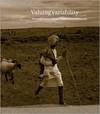The major livestock countries in the Sahel (such as Niger, Mali and Burkina Faso) offer little support to the livestock sector, both in proportion to the general State budget and compared to the support provided to crop farming. This brief, produced in partnership with the APESS network, is based mainly on data collected in four countries: Burkina Faso, Mali, Niger and Senegal. In the brief it is argued that the reasons for the paradox between a livestock sector with considerable stakes and (relatively) weak support are many, for instance many decision makers, see herders as affluent populations, meaning their vulnerability to climate hazards is often not considered.
Year of publication: 2015Organization:
Topic: Économie
Language: English, Français
Type of document: Technique
Geographical coverage: Afrique occidentale
This publication aims to determine the economic contribution of camel milk to pastoral households in Somali Regional State, in eastern Ethiopia. It also looks at all other value chain actors incolced in the marketing of camel milk, and tries to assess camel milk marketing channels and price margins along the value chain.
The study shows that camel milk makes a substantial economic contribution to pastoralist households and those involved in marketing camel milk, and there is good potential for market-oriented camel dairy development.
Year of publication: 2015Organization: Institut international pour l'environnement et le développement (IIED)
Topic: Économie, Sécurité alimentaire
Language: English
Type of document: Technique
Geographical coverage: Afrique orientale
This book is a challenge to those who see the drylands as naturally vulnerable to food insecurity and poverty. It argues that improving agricultural productivity in dryland environments is possible by working with climatic uncertainty rather than seeking to control it – a view that runs contrary to decades of development practice in arid and semi-arid lands. Across China, Kenya and India – and most other dryland countries – family farmers and herders relate to the inherent variability of the drylands as a resource to be valued, rather than a problem to be avoided. By exploring these vibrant agricultural economies that take advantage of variability, this book inverts longstanding negative views about food security in the drylands.
Year of publication: 2015Organization: Institut international pour l'environnement et le développement (IIED)
Topic: Économie, Sécurité alimentaire, Régime foncier, Résilience
Language: English
Type of document: Technique
Geographical coverage: Global
La présente loi fixe les principes fondamentaux et les règles générales régissant l'aménagement et la gestion des espaces pastoraux et sylvo-pastoraux, l'utilisation et le développement des ressources pastorales, la transhumance pastorale et la mobilité des troupeaux.
Year of publication: 2015Organization: Auteurs individuels
Topic: Régime foncier, Organisation
Language: Français
Type of document: Politiques et législation
Geographical coverage: Afrique du Nord
L'objectif de cette étude est d’améliorer durablement la gestion des conflits liés à la transhumance transfrontalière en Afrique de l’Ouest, dans un contexte de changements globaux (variabilité et changement climatiques, pression foncière, dégradation de la biodiversité, maladies animales émergentes et ré-émergentes, etc.). Elle a permis notamment d’améliorer les connaissances sur les déterminants de la transhumance transfrontalière et des conflits, d’analyser le cadre politique et juridique, de documenter les innovations et les bonnes pratiques de gestion durable des ressources pastorales, et de proposer des options stratégiques de prises de décision pour une gestion apaisée de la transhumance transfrontalière en Afrique de l’Ouest.
Year of publication: 2015Organization: Auteurs individuels
Topic: Conflit, Régime foncier
Language: Français
Type of document: Technique
Geographical coverage: Afrique occidentale
Resource mapping can assist in investigating rangeland management systems, negotiating resource management plans, and implementing and monitoring progress in Participatory Rangeland Management (PRM). These guidelines, prepared for development practitioners working in the rangelands of Ethiopia, will contribute to achieving more sustainable use of rangeland resources and arresting and reversing degradation. They will thus contribute to improved livestock productivity, greater resilience of pastoralist communities and reduced poverty.
The guidelines outline the three stages of a mapping exercise – preparation, facilitation and validation – and provide information on the purpose, methods and planned outcomes of each stage. The final section brings examples of the practical application of participatory resource mapping within PRM.
Organization: Agence des États-Unis pour le développement international
Topic: Changement climatique, Services environnementaux, Peuples autochtones, Régime foncier, Participation
Language: English
Type of document: Technique
Geographical coverage: Afrique orientale
Although livestock represents a significant portion of Gross Domestic Product (GDP) and supports millions of livelihoods, especially in sub-Saharan Africa, this sector is seriously constrained by animal diseases, inadequate investments, and unfavourable government policies.
The COMESA Regional Livestock Policy Framework aims to support the strengthening of COMESA to play its role of coordination, harmonization, integration and support to countries with the aim to stimulate a more conducive environment for public and private investments in the livestock sector. It relies heavily on the review of livestock and related policies of member states and expansive body of literature and research on animal agriculture in the COMESA region, the livestock trade, its economics and sociology. This policy has implications for pastoralists in Eastern and Southern Africa, that occupy arid and semi-arid lands and contribute greatly to the livestock economy.
Year of publication: 2015Organization: Marché commun de l’Afrique orientale et australe
Topic: Économie, Services environnementaux, Sécurité alimentaire, Résilience, Value addition
Language: English
Type of document: Politiques et législation
Geographical coverage: Afrique orientale, Afrique australe
This paper discusses providing education to children from families with mobile livelihoods. It includes case studies from nomadic groups’ education in Kenya, India, Afghanistan and Indonesia.
Year of publication: 2015Organization: Auteurs individuels
Topic: Éducation
Language: English
Type of document: Scientifique
Geographical coverage: Global









